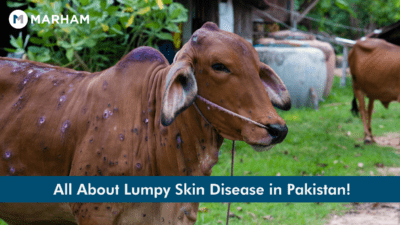Every year many animals face an infectious viral Lumpy skin disease in Pakistan. It is an eruptive, contagious, and infectious viral disease characterized by nodules on the body’s skin. In some cases, secondary bacterial infections often worsen the condition.
Traditionally, this disease is present in Eastern and Southern Africa. Later in the 1970s, it spread to the Northwest through the continent into Sub-Saharan West Africa.
Since 2000, it has spread to various Middle East countries. In 2013, it spread to the west into Turkey and so on.
If you want to learn more about lumpy skin disease, lumpy skin disease treatment medicine, how it spreads, how it can be controlled, and whether it is harmful to humans or not, then keep reading!
What is Lumpy Skin Disease?
Lumpy skin disease is a viral infection that is highly contagious in animals including cattle. It mainly affects livestock animals.
It is also known as cow disease. It infects cattle and buffaloes along with cows.
An important pox virus known as the lumpy virus affects animals. It is transmitted by blood-feeding insects such as ticks, mosquitoes, and flies. It causes fever, and nodules on the skin. It can also lead to death, especially in animals that have never been exposed to the virus.
ALSO READ: پاکستان میں لمپی سکن وائرس : اس کے بارے میں سب کچھ جاننے کی ضرورت ہے۔
How Does Lumpy Skin Disease Spread?
Let’s deeply dive into how it actually spreads. There are two main ways in which lumpy skin disease spreads which are as follows:
- Vector Borne Transmission
Like malaria or dengue, lumpy skin disease can spread through the bite of flies, ticks, or mosquitoes. This type of spreading is known as vector-borne transmission in which the disease spreads through any vector.
- Contact Transmission
As it is a viral disease, it can spread from one animal to another via direct physical contact. This is a common scenario in cattle houses where animals are always directly in contact with each other.
What Does Lumpy Skin Disease Look Like?
In the case of Lumpy Skin Disease, not all animals show the signs and symptoms of the disease. Yes, you read it right. It can be asymptomatic in some animals.
However, in the case of symptomatic disease, it shows the following signs and symptoms:
- Skin nodules appearing on any part of the body (up to 50mm)
- Fever
- Reduced milk production
- Development of scabs in nodules leaving behind large holes
- Nasal discharge
- Genitals Swelling
- Lymph node swelling
- Watery eyes
- Temporary and permanent infertility problems (in animals)
Eid-ul-Azha and the Spread of Lumpy Skin Disease
On Eid-ul-Azha, people slaughter animals and there are castles, cows, goats, and other animals everywhere in close proximity to each other.
Pakistan has faced a Lumpy skin disease outbreak in Sindh that hit approximately 5 million sellers of the cattle industry.
Lumpy skin disease in Pakistan cannot only impact meat and milk production but can also impact the profitable cattle industry.
ALSO READ: Lumpy Skin Disease Outbreak: Can Humans Get Infected?
How to Control the Spread of Lumpy Skin Disease in Pakistan?
You can follow a few tips to control the spread of Lumpy Skin Disease in Pakistan.
- Keep the infected animals isolated from the animals to prevent the spread of disease
- Antibiotics and NSAIDs can aid in controlling the spreading of secondary bacterial infections
- Viral vaccination
- Ban the trading of live animals
- Good nursing care of animals can help to overcome the side effects of the disease
- Bulls that are used for breeding must be tested for LSDV
Despite low death rates due to lumpy skin disease, we know the contagious disease can quickly spread.
Is Lumpy Skin Disease Harmful for Humans?
If you are thinking that it is a viral disease and it can spread to humans as well. Then, you might be wrong!
Lumpy Skin Disease is not transmitted to humans. Health authorities have approved that the meat of the infected animals is totally safe to consume. However, the meat of the affected animals should be properly and completely cooked before eating.
Lumpy Skin Disease Treatment Medicine
Generally, for every viral disease, there is an antiviral or vaccination that is used to treat that disease. However, in the case of Lumpy Skin Disease, it has no direct antiviral treatment.
However, supportive care to the animals acts as lumpy skin disease treatment medicine. It involves the following:
- Wound Care Sprays: Wound care sprays treat skin lesions to prevent the further spread of infection.
- Antibiotics: Some veterinary doctors also prescribe antibiotics to prevent secondary bacterial infection and pneumonia.
- IV Fluids: IV fluids are used to provide additional nutrition. They also help in reducing symptoms.
- Anti-Inflammatory Painkillers: Anti-inflammatory painkillers reduce pain and give sick animals relief and energy to eat again.
Wrap Up!
Lumpy Skin Disease in Pakistan is a viral infectious disease that primarily infects animals and cattle.
There are mainly two modes of transmission of lumpy skin disease. Pakistan once faced the Lumpy Skin Disease outrage in Sindh.
Currently, there is no treatment or vaccination for Lumpy skin disease. However, supportive care to the animals acts as lumpy skin disease treatment medicine.
Frequently Asked Questions (FAQs)
1. What is the best treatment for lumpy skin disease?
Attenuated vaccination is the most promising and best treatment to control lumpy skin disease.



